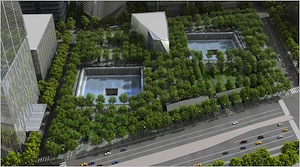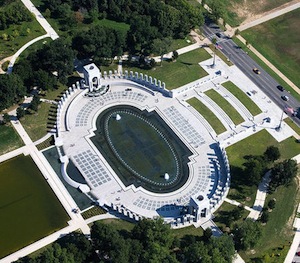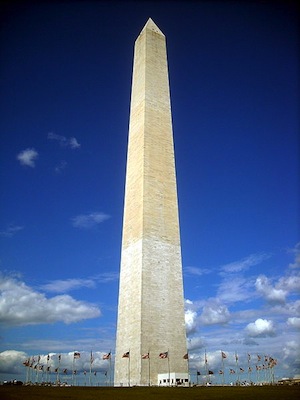Regardless of whatever else transpires around the world, there will soon be a daily onslaught of coverage about the tenth anniversary of the attacks that September day at the century's debut. It will include all manner of complaint and recrimination about the ground zero location itself, alongside calmer if sometimes treacly personal remembrances of the victims themselves.
With this crush in mind, the May 1792 quote above from Secretary of State, Thomas Jefferson, in a letter to President Washington, seems a good one to bear in mind as an important civic lesson and all-around pick-me-up. While in this particular instance Jefferson was resigning himself to bureaucratic delay at the expense of rapid but risky intervention in matters of European belligerence, it remains an aphorism of permanent currency. At their best, democracies and their attendant and inevitable systems of human checks and balances bear it out repeatedly.

The acts of personal remembrance taking place at this official memorial site honoring the dead at all three crash sites will prompt a catharsis of collective remembrance combined with the will to carry on, as allowed by architect Michael's Arad's powerful and enveloping inverted twin ziggurats of waterfalls and reflecting pools.
The ten years it took is just right. So-called delay is actually a benediction. Intervening events that often seemed like delays were instead a sum of outcomes spawned by competing and largely honorable intent. Errors were thus avoided, whether rendered apparent along the way and fallen to an invisible wayside by virtue of the dilatory process itself. All this time heralds a job well-done and a testimony to what turns out to be historical significance as large as first imagined, born out by ensuing policy decisions and the trajectory of world events.
The upcoming encounters at the approximate footprints of the towers themselves will soon eclipse memories of endless bickering and self-serving political tactics all amplified by the ephemeral daily crossfire of pundits and take-no-prisoner stakeholders alike.
For starters there were many who at least tacitly imagined that global terrorism would soon inflict a calculus of loss overshadowing 9/11 perhaps catastrophically. Others feared that a forgetful nation would invite or even trigger such events. Still others warned that we risked losing sight of the tragedy altogether in the crush of subsequent events; a culture of irony at a time of virtual attention spans meant: build it now or never. "There's nothing there but a mud pit" became the refrain even as commuter trains kept running, minute human remains were exhumed with microscopic care under the gaze of vigilant survivors, and a complex infrastructure was exactingly realized.

Such naysayers are now rendered mute. None proved true. A decade reveals that the historical weight assigned at the time has been borne out by the facts of time intervening. There has not been a comparable tragedy, at least on American soil, and the reasons why range from a new type of warfare, to the sacrifices of privacy and freedom of movement, to prejudices of creed previously unknown. Fear both real and incited propelled division. Good and bad, September 11 turns out to be the pivot imagined. A decade of waiting has made it manifest.
Bearing in mind the new Martin Luther King, Jr. National National Memorial on the Mall, opening 48 years after his " I Have a Dream" speech (and 43 after his murder), any study of American memorial construction tells a comparable story of time taken to ultimate benefit. Here again prospective error over the events of 9/11 was averted. Examples abound.
National World War II Memorial on the Mall in Washington DC by Friedrich St. Florian was dedicated 59 years after VJ Day. (And even seven years after its selection in a global design competition.) While many critics condemn it, its classical equipoise and advancing patina embrace visiting veterans, their descendants, and a still grateful world with like measure. It succeeds at its task. Its delay paradoxically reveals the enormity of its subject. It took such an interlude to render it in stone at the nation's governmental crossroads in honor of so many united in service yet in so many distinct ways across the entire globe.
The USS Arizona Memorial by Honolulu architect, Alfred Preis, marking America's Pearl Harbor entry to that same war took 21 years to realize. When complete Pries stated with prophetic insight into memorial architecture at its most enduring, "Overtones of sadness have been omitted to permit the individual to contemplate his own personal responses and innermost feelings." A generation of waiting meant a dispelling of immediate grief. The paradoxical result is that the victims' loss resounds more strongly over time, especially among those discovering the crucible events of the tragic attack for the first time.

And while more celebratory than mournful, the official memorial to Mr. Jefferson's boss, George Washington, in all its classical majesty (as still the world's tallest obelisk, crack or no crack) was only commissioned in 1836 -- 40 years after he died. Even then, completion of the Washington Monument took another 48 years, beset by budget woes, insufficient fund raising, and a great civil war begun, in all places, in its architect's native city: Robert Mills of Charleston South Carolina.
The result is a design masterpiece cherished by classicists and modernists alike for its ageless simplicity, along with a public awestruck by its spiny majesty and enticing ascent. The base terrace and colonnade first envisioned by Mills turned out to be wrong. A productive delay is literally etched in stone with the shifting color that resulted from the necessity of a new quarry source due to such endless political, aesthetic and financial squabbling. A tribute to ends over means.
In terms both historical and formal, the National 9/11 Memorial has gained from the many forces that demanded a decade. Jefferson had it right.